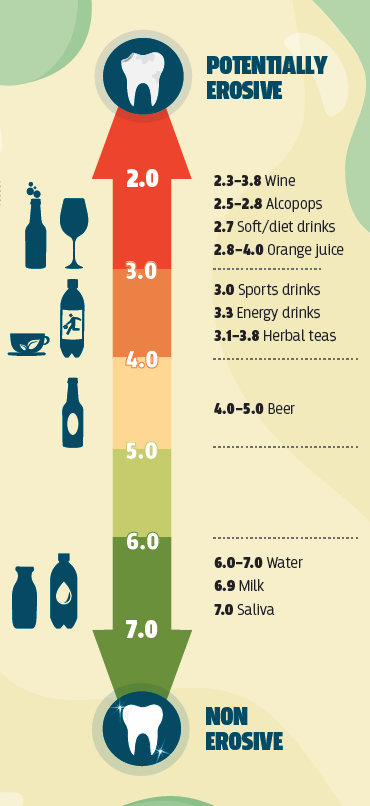
Dental health
Dairy foods including milk, cheese and yoghurt have a specific role to play in dental health. They contain a unique combination of special anti-decay and protective nutrients such as calcium, phosphorus and the protein, casein.
The role of milk, cheese and yoghurt in dental health
Studies show that milk, yoghurt and hard cheese are not linked to dental erosion.1, 2 In addition, research has also shown calcium, casein and whey are inversely associated with periodontitis (gum disease) in adults.3
Casein, when combined with calcium and phosphorus in saliva, can assist with remineralisation of tooth enamel by providing a protective film over the tooth, reducing the risk of decay.4, 5
Milk has been linked to decreased risk of cavities, making it a good drink choice between meals. Milk, naturally contains the sugars lactose and galactose, which are regarded as less cariogenic than other sugars, especially when they are accompanied by calcium in dairy products which can counter potential damage to teeth.6 Flavoured milks are a good alternative to sugar sweetened beverages (soft drinks, sports drinks, cordials etc.) or juices as they are non-acidic and contain teeth-friendly nutrients.7
The following figure shows the erosive nature of different drinks:

Like milk, yoghurt also has a negligible or low impact on tooth decay if the sugar content is 5% or less.8 As food labels in Australia list ‘total sugars’ as opposed to ‘added sugars’ (and because milk and yoghurt naturally contain lactose), look for flavoured milks and flavoured yoghurt that contain 10g per 100mL or less of ‘total sugars’.
Studies have also shown eating hard cheese is linked to decreased risk of dental cavities and erosion. Eating a small piece of cheese after consuming sugary food or drink is recommended to help protect teeth and reduce the risk of tooth decay – this is because cheese helps to stimulate salivary flow which neutralises the acid pH of the mouth following exposure to sugar.9 Saliva is the body’s natural defence against tooth decay and tooth erosion.
Despite these benefits to dental health, only one quarter of females and half of the Australian adult male population met their calcium requirements in the latest National Health Survey.10 Milk, cheese and yoghurt are the richest sources of calcium in the Australian diet11 however most Australians need to increase their daily serves to meet the Australian Dietary Guidelines recommendations.
Diet and dental health explained
Results from the latest National Health Survey show Australians are overconsuming discretionary (‘junk’) foods and are not consuming enough foods from the five food groups. It was revealed that 34% of the Australian population consume sugar-sweetened beverages including soft drinks, sports drinks, flavoured mineral water and juices.12 Sugar-sweetened beverages vary in the quantity and nature of the sugars they contain, for example diet soft drinks are lower in sugar, or contain artificial sweeteners. While these types of drinks are lower in kilojoules than standard varieties, they are still acidic meaning consumption may be associated with increased risk of tooth erosion.13
It’s not only the type of sugary drink or food that's consumed, but also the amount and frequency of consumption.14 The frequency of snacking and sipping on sugary and acidic drinks should be limited to decrease the risk of developing tooth decay. It’s for this reason that if sugary foods and drinks are consumed, they should be consumed as part of a meal, which reduces frequency of acid attacks.15
Looking after our teeth is a lifelong commitment. Here are some tooth-friendly tips for your patients about what to eat and drink:
- When possible, drink tap water, rather than bottled water, as it usually contains fluoride at a level that helps to protect against tooth decay.16
- Offer children milk or water – the only recommended drinks for children.
- Limit intake of sugary drinks and foods. Sugary drinks include soft drinks, sports drinks, vitamin waters, cordials, fruit juice, fruit drinks and energy drinks.
- Limit intake of acidic drinks, such as fruit juice, sports drinks, soft drinks, wine, alcopops and ‘diet’ or artificially sweetened soft drinks.
Dental health resources
Dental health posters
Download the Dental health poster
Dental health fact sheets
Download the Dental health fact sheet
Download the Good health fact sheet - Drinks for Children
Dental health position papers
Download the Dairy and dental health paper
1 Li H, Zou Y, Ding G. Dietary factors associated with dental erosion: a meta-analysis. PLoS One. 2012;7(8):e42626.
2 Moynihan P, Petersen P. Diet, nutrition and the prevention of dental diseases. Public Health Nutr. 2004;7(1a).
3 Adegboye A, Boucher B, Kongstad J, Fiehn N, Christensen L, Heitmann B. Calcium, vitamin D, casein and whey protein intakes and periodontitis among Danish adults. Public Health Nutr. 2015;19(03):503-10.
4 Danielsson Niemi L, Hernell O, Johansson I. Human milk compounds inhibiting adhesion of mutans streptococci to host ligand-coated hydroxyapatite in vitro. I Caries Res. 2009;43(3):171-8.
5 Llena C, Forner L, Baca P. Anticariogenicity of casein phosphopeptide-amorphous calcium phosphate: a review of the literature. J Contemp Dent Pract. 2009;10(3):1-9.
6 Ravishankar TI, et al. Effect of consuming different dairy products on calcium, phosphorus and pH levels of human dental plaque: a comparative study. Eur Arch Paediatr Dent. 2002;13:144-8.
7 Levine R. Milk, flavoured milk products and caries. Br Dent J. 2001;191(1):20.
8 Levine R. Milk, flavoured milk products and caries. Br Dent J. 2001;191(1):20.
9 Kashket S, DePaola D. Cheese consumption and the development and progression of dental caries. Nutr Rev. 2002;60(4):97-103.
10 Australian Bureau of Statistics [Internet]. Canberra: ABS; 2015. Australian Health Survey: Usual Nutrient Intakes, 2011-12. Cat. 4364.0.55.008. [updated 2015 Apr 27; cited 2016 Feb 15]. Available: http://www.abs.gov.au/ausstats/abs@.nsf/Lookup/by%20Subject/4364.0.55.008~2011-12~Main%20Features~Key%20findings~100
11 Australian Bureau of Statistics [Internet]. Canberra: ABS; 2015. Australian Health Survey: Usual Nutrient Intakes, 2011-2012. Cat 4364.0.55.008. [updated 2015 Apr 27; cited 2016 Feb 15]. Available: http://www.abs.gov.au/ausstats/abs@.nsf/Lookup/by%20Subject/4364.0.55.008~2011-12~Main%20Features~Calcium~401
12 Australian Bureau of Statistics [Internet]. Canberra: ABS; 2015. Australian Health Survey: Nutrition First Results - Foods and Nutrients, 2011-12. Cat 4364.0.55.007. [updated 2015 Oct 15; cited 2016 Feb 09]. Available: http://www.abs.gov.au/ausstats/abs@.nsf/Lookup/by%20Subject/4364.0.55.007~2011-12~Main%20Features~Discretionary%20foods~700
13 Salas MM, Nascimento GG, Vargas-Ferreira F, Tarquinio SB, Huysmans MC, Demarco FF. Diet influenced tooth erosion prevalence in children and adolescents: Results of a meta-analysis and meta-regression. J Dent. 2015;43(8):865-75. doi: 10.1016/j.jdent.2015.05.012. Epub 2015 Jun 7.
14 Bernabe E, Vehkalahti M, Sheiham A, Lundqvist A, Suominen A. The shape of the dose-response relationship between sugars and caries in adults. J Dent Res. 2015;95(2):167-72.
15 Moynihan P, Petersen P. Diet, nutrition and the prevention of dental diseases. Public Health Nutr. 2004;7(1a).
16 National Health and Medical Research Council. Australian Dietary Guidelines, Canberra: Commonwealth of Australia; 2013.


